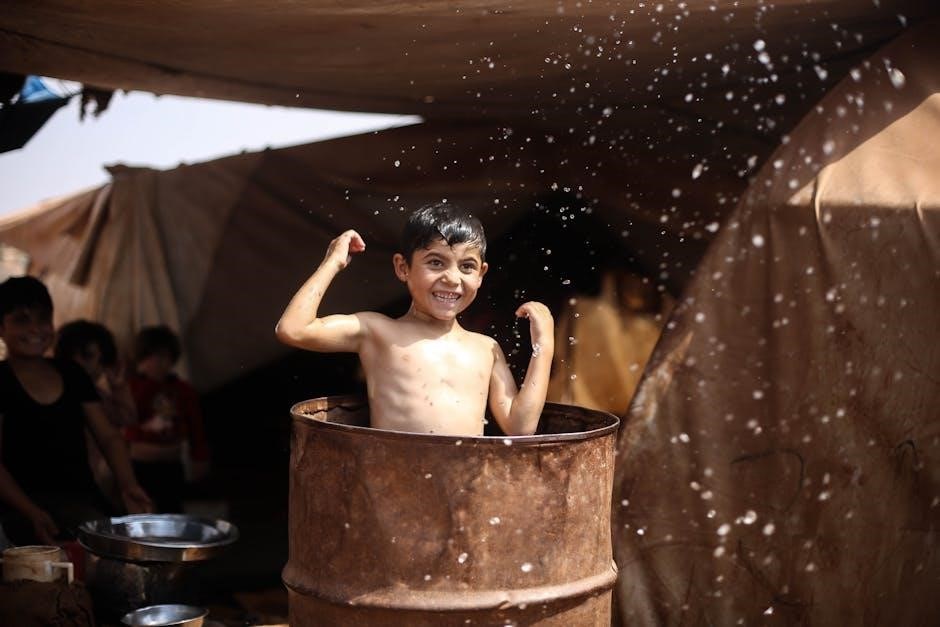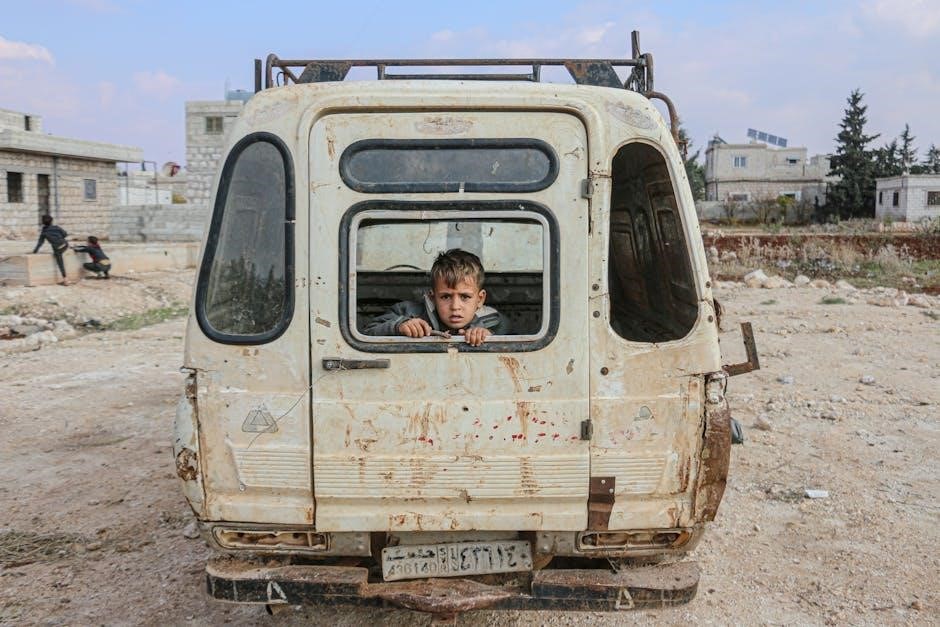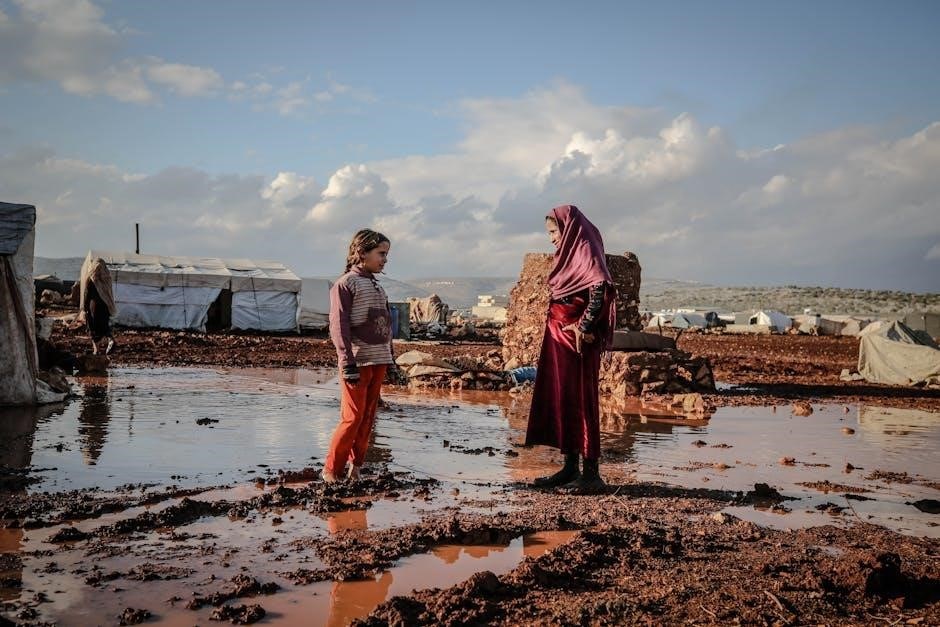Survival at Auschwitz required immense resilience, as prisoners faced brutal conditions, Nazi selections, and constant threats of death. Their stories reveal the strength of the human spirit.
Historical Context of Auschwitz Concentration Camp
Auschwitz, established in 1940 near Oswiecim, Poland, was the largest Nazi concentration and extermination camp. Initially intended for Polish political prisoners, it evolved into a central site for the Holocaust. By 1942, Auschwitz-Birkenau became a major death camp, equipped with gas chambers for mass murder. Over 1.1 million people, primarily Jews, were systematically killed. The camp also served as a labor complex, exploiting prisoners in brutal conditions; Auschwitz symbolized the Nazi regime’s genocidal policies and industrialized murder. Its liberation on January 27, 1945, by Soviet forces exposed the horrors to the world, making it a pivotal historical site for understanding the Holocaust’s atrocities.
The Purpose of the Article: Understanding Survival Stories
This article explores the profound importance of understanding survival stories from Auschwitz, offering insights into the resilience of the human spirit. By examining personal accounts, historical context, and the psychological toll of survival, the article aims to honor the victims and educate future generations. The stories of survivors like Eva Clarke, Arek Hersh, and others reveal the complexities of life in the camp, the moral dilemmas faced, and the enduring impact of trauma. These narratives serve as a testament to human strength and a warning against the horrors of oppression, ensuring the lessons of Auschwitz are never forgotten. Their experiences provide a deeper understanding of survival, hope, and the human condition.

Notable Survivors of Auschwitz
Among the notable survivors of Auschwitz are Eva Clarke, Arek Hersh, and others who endured unimaginable horrors. Their testimonies reveal the strength and resilience of those who survived the camp’s brutal conditions, offering a glimpse into the human spirit’s capacity to endure even in the darkest times.
Eva Clarke and Her Family’s Survival Story
Eva Clarke and her mother, Anka, were the only survivors of their family, with 15 relatives murdered in Auschwitz. Born in 1945 within the camp, Eva’s birth occurred amid unimaginable hardship. Her mother’s determination and resilience were crucial to their survival. The family endured severe conditions, including Nazi selections, starvation, and exhaustion. Despite the trauma, Eva and her mother managed to stay together, a rare occurrence in the camp. Their story highlights the strength of familial bonds and the will to live despite overwhelming odds. Eva now shares her experiences to educate future generations about the Holocaust and its impact on families like hers.
Arek Hersh: Survival in Lodz Ghetto and Auschwitz
Arek Hersh endured unimaginable hardship, surviving both the Lodz Ghetto and Auschwitz. Born into a Jewish family, he experienced the horrors of Nazi occupation from an early age. After being forced into the Lodz Ghetto, Arek was later deported to Auschwitz, where he witnessed the brutal separation of families during Nazi selections. Despite the overwhelming odds, he managed to survive the camp’s harsh conditions, including forced labor, starvation, and disease; Arek’s resilience and determination allowed him to endure until liberation. His story highlights the profound human capacity to survive even in the face of unimaginable cruelty, serving as a testament to the strength of the human spirit during one of history’s darkest periods.
Ruth Cohen, Steven Fenves, and Irene Weiss: Teenage Survivors
Ruth Cohen, Steven Fenves, and Irene Weiss were among the teenage survivors of Auschwitz-Birkenau, deported from their hometowns during the Holocaust. Ruth, just 16, endured forced labor and starvation, relying on inner strength to survive. Steven, a young boy, witnessed unimaginable horrors but found hope in small acts of kindness. Irene, barely 13, faced the camp’s brutal conditions, clinging to her will to live. Their stories highlight the resilience of youth in the face of unimaginable suffering, offering a poignant glimpse into the emotional and psychological struggles of teenage survivors.

Psychological and Emotional Struggles
Survivors of Auschwitz endured profound psychological trauma, grappling with survivor guilt, anxiety, and emotional scars, yet found resilience through hope and the will to survive.
The Trauma of Nazi Selection Processes
The Nazi selection processes at Auschwitz were a constant source of terror and uncertainty for prisoners. Upon arrival, individuals were subjected to instantaneous judgments by SS officers, determining whether they would be sent to forced labor or immediate extermination. These selections were arbitrary and inhumane, leaving prisoners in a state of perpetual fear. The trauma was compounded by the sight of family members and loved ones being separated, often never to be seen again. Survivors like Eva Clarke and Arek Hersh recount the psychological toll of these processes, which instilled a deep sense of helplessness and dread. The selections became a defining feature of life in Auschwitz, leaving lasting emotional scars on those who endured them.
Mental Resilience and Coping Mechanisms
Survivors of Auschwitz employed extraordinary mental resilience to endure unimaginable horrors. Many relied on hope, maintaining a belief in a future beyond the camp. Others used humor or silent acts of defiance to preserve their humanity. Prisoners formed tight-knit support networks, sharing what little they had and offering emotional strength. Mental strategies, such as focusing on survival for loved ones or finding meaning in their existence, played a crucial role. These coping mechanisms, though varied, were essential for navigating the psychological torment and maintaining a sense of self amidst dehumanizing conditions.
The Role of Hope in Survival
Hope played a crucial role in the survival of Auschwitz prisoners, serving as a psychological anchor amidst unimaginable horrors. Many survivors, like Eva Clarke and Arek Hersh, credited hope as their driving force. It manifested in the belief of reunification with loved ones, the desire to bear witness, or the determination to endure for a future beyond the camp. Even in the darkest moments, hope fueled resilience, enabling prisoners to cling to life despite starvation, disease, and brutal conditions. Shared stories of survival and whispered promises of a better tomorrow sustained this fragile yet powerful emotion, becoming a collective lifeline in the camp.

Physical Conditions in Auschwitz
Prisoners endured overcrowding, poor sanitation, and inadequate food, leading to widespread disease and exhaustion. Harsh labor, extreme weather, and lack of proper clothing exacerbated their suffering.
Daily Life in the Camp: Work, Hunger, and Exhaustion
Daily life in Auschwitz was marked by relentless labor, starvation, and physical exhaustion. Prisoners were forced into grueling work, often for over 12 hours a day, under the threat of death. The meager rations provided were insufficient, leading to widespread malnutrition and related health issues. Many succumbed to exhaustion or starvation, as the Nazi regime sought to exploit prisoners to their limits. The harsh conditions, combined with constant fear, created an environment where survival was a daily struggle. Despite the brutality, some managed to endure, relying on resilience and hope to navigate the unimaginable hardships of camp life.
Disease and Health Challenges in the Camp
Disease and health challenges were rampant in Auschwitz due to overcrowding, poor sanitation, and malnutrition. Prisoners suffered from typhus, dysentery, and other infectious diseases, with limited medical care available. Many died from untreated illnesses exacerbated by starvation and exhaustion. The lack of hygiene facilities and constant exposure to disease-bearing insects further worsened conditions. Survivors often relied on makeshift treatments or the help of fellow prisoners to combat sickness. Despite these challenges, some managed to survive by sharing scarce resources or receiving minimal care from overburdened camp medics. The health crisis in Auschwitz underscored the brutal living conditions and the Nazi regime’s disregard for human life.
Execution, Torture, and Starvation as Tools of Control
Nazi authorities at Auschwitz employed execution, torture, and starvation as systematic tools to exert control over prisoners. Execution was often arbitrary, used to instill fear and maintain discipline. Torture, both physical and psychological, was inflicted to break prisoners’ spirits and extract information. Starvation was a deliberate tactic, with meager rations leaving prisoners weakened and vulnerable. These methods were designed to suppress resistance and maintain a climate of terror. The constant threat of death and suffering became a means of psychological control, ensuring compliance and crushing hope. Such brutal practices highlight the regime’s relentless pursuit of domination and dehumanization.

The Role of Support Networks
Support networks, including familial bonds and mutual aid among prisoners, played a crucial role in survival, offering emotional strength and practical help amidst unimaginable hardship and despair.
Familial Bonds and Mutual Aid
Familial bonds and mutual aid played a crucial role in survival at Auschwitz. Many prisoners relied on family members or close-knit groups for emotional and physical support. Sharing scarce resources, such as food or clothing, became a lifeline. For instance, Eva Clarke and her mother, Anka, survived by staying together and supporting each other through the harsh conditions. Similarly, teenagers like Ruth Cohen, Steven Fenves, and Irene Weiss formed strong bonds, helping one another endure the camp’s brutality. These connections provided hope and strength, enabling survivors to face the unimaginable hardships. Mutual aid became a vital strategy, fostering resilience and unity in the face of despair.
Support from Other Prisoners and Camp Networks
Support from fellow prisoners played a crucial role in survival at Auschwitz. Many formed close bonds, sharing scarce resources like food and clothing. Prisoners often risked their lives to protect one another, creating networks of solidarity. These connections provided emotional strength and hope, helping individuals endure the camp’s brutal conditions. Mutual aid was essential, as prisoners relied on each other for survival. Such acts of humanity amidst unimaginable horrors underscored the resilience of the human spirit and the importance of camaraderie in the face of adversity. These networks were often the only source of comfort and support in an environment designed to destroy hope and dignity.

Liberation and Aftermath
Liberation on January 27, 1945, marked the end of Auschwitz’s horrors. Survivors faced immense physical and emotional challenges, struggling to rebuild lives and find loved ones.
The Liberation of Auschwitz: A Turning Point
The liberation of Auschwitz on January 27, 1945, marked a pivotal moment in history. Soviet troops of the Red Army discovered the camp, freeing approximately 7,000 survivors, many in critical condition. The liberation brought an end to unimaginable suffering but also revealed the full extent of Nazi atrocities. Survivors expressed a mix of relief, hope, and trauma as they began their journey toward recovery. This event symbolized the collapse of the Nazi regime and served as a turning point for survivors, allowing them to rebuild their lives. The liberation of Auschwitz remains a powerful reminder of the Holocaust’s horrors and the resilience of those who endured it. It also underscored the importance of preserving their stories for future generations.
Post-Liberation Challenges for Survivors
After liberation, Auschwitz survivors faced immense challenges, including physical and emotional scars. Many suffered from malnutrition, disease, and long-term health issues due to camp conditions. Psychological trauma, such as survivor guilt and anxiety, lingered, affecting their ability to rebuild lives. Families had been destroyed, leaving survivors without support networks; Reintegrating into society was difficult, with many facing stigma or disbelief about their experiences. Some struggled to find purpose, grappling with the loss of loved ones and the moral dilemmas of survival. Despite these hurdles, survivors like Eva Clarke and Arek Hersh shared their stories, ensuring the Holocaust’s lessons were not forgotten. Their resilience continues to inspire, highlighting the strength of the human spirit in overcoming unimaginable adversity.

Commemoration and Education
The Auschwitz-Birkenau State Museum preserves history, while survivor memoirs like Eva Clarke’s and Irene Weiss’s stories educate future generations about the Holocaust’s horrors and resilience.
The Auschwitz-Birkenau State Museum’s Role
The Auschwitz-Birkenau State Museum plays a vital role in preserving the history of the Holocaust and honoring its victims. Established in 1947, the museum serves as a memorial and educational site, offering insights into the atrocities committed during World War II. It showcases personal belongings, documents, and testimonies of survivors, providing a poignant reminder of the camp’s dark past. The museum also hosts exhibitions and educational programs to raise awareness about the Holocaust, ensuring future generations understand its significance. By sharing survivors’ stories, the museum fosters remembrance and promotes tolerance, becoming a cornerstone in Holocaust education and commemoration efforts worldwide.
Survivor Memoirs: Preserving History
Survivor memoirs play a vital role in preserving the history of Auschwitz, offering personal accounts of resilience and suffering. Authors like Primo Levi, Viktor Frankl, and Elie Wiesel shared their experiences, providing profound insights into life in the camp. These memoirs highlight the emotional and psychological struggles, as well as the hope that sustained many. They serve as educational tools, ensuring future generations understand the atrocities of the Holocaust. Institutions like the Auschwitz-Birkenau State Museum further promote these narratives, emphasizing the importance of remembrance. Through these stories, survivors honor the memories of those lost while educating the world about the horrors of Auschwitz.
Modern Efforts to Educate About the Holocaust
Modern initiatives emphasize Holocaust education through digital platforms, virtual tours of Auschwitz, and documentaries. Survivors’ memoirs, like those of Viktor Frankl and Edie Eger, provide deep personal insights.
The Auschwitz-Birkenau State Museum collaborates with educators globally to develop curricula and host international remembrance events. These efforts ensure future generations understand the atrocities of Auschwitz.

Moral and Ethical Dilemmas
Survivors faced unbearable choices, such as sacrificing others to survive, leading to lifelong guilt. These dilemmas highlight the psychological toll of Nazi oppression and moral decay.
Survivor Guilt and Its Impact
Survivor guilt profoundly affected many Auschwitz survivors, leaving lasting emotional scars. This phenomenon, where individuals felt remorse for surviving while others perished, was common among those who endured the camp’s horrors. Survivors often grappled with feelings of inadequacy, questioning why they lived while loved ones died. Eva Clarke, for instance, expressed deep sorrow over the loss of her family, while others like Arek Hersh carried the weight of surviving the Lodz Ghetto and Auschwitz. Survivor guilt manifested in lifelong struggles with mental health, self-blame, and a haunting sense of responsibility. Memoirs and testimonies reveal how this guilt shaped their post-war lives, emphasizing the psychological toll of survival. The burden of guilt remained a defining aspect of their experiences, underscoring the profound emotional aftermath of Auschwitz.
Ethical Questions Surrounding Survival
The ethical dilemmas faced by Auschwitz survivors raise profound questions about morality in extreme circumstances. Many grappled with guilt over decisions made to survive, such as prioritizing their own lives over others or avoiding acts of resistance. The Nazi regime’s dehumanizing conditions forced prisoners into impossible choices, challenging traditional notions of right and wrong. Survivors often questioned whether their actions, however necessary, aligned with their moral values. These ethical struggles highlight the psychological toll of survival and the lasting impact on their consciences. The complexities of these decisions continue to spark debates about humanity, sacrifice, and the limits of ethical behavior in the face of unimaginable horror.

Long-Term Effects on Survivors
Survivors of Auschwitz often carried physical and emotional scars, struggling with survivor guilt and rebuilding their lives after enduring unimaginable trauma and loss during the Holocaust.
Physical and Emotional Scars Post-War
Survivors of Auschwitz often bore deep physical and emotional scars long after liberation. Many suffered from malnutrition, chronic illnesses, and disabilities caused by forced labor and inadequate medical care.
Emotionally, the trauma of witnessing mass murder, enduring Nazi selections, and losing loved ones left lasting psychological damage. Survivor’s guilt, anxiety, and depression became lifelong struggles for many.
Some survivors experienced recurring nightmares and flashbacks, while others faced challenges rebuilding their lives, reconnecting with families, and finding purpose in a post-war world that often struggled to understand their ordeal. These scars served as poignant reminders of the Holocaust’s enduring impact.
Rebuilding Lives After Auschwitz
After liberation, Auschwitz survivors faced immense challenges in rebuilding their lives. Many suffered from physical and emotional scars, including survivor’s guilt and trauma. Reconnecting with families was often impossible, as most had perished. Survivors like Eva Clarke and Arek Hersh became advocates for Holocaust education, sharing their stories to honor the dead. Others, like Ruth Cohen and Irene Weiss, rebuilt their lives in new countries, creating families and careers despite the pain of their past. The resilience of these individuals serves as a testament to the human spirit’s capacity for renewal and hope, even in the face of unimaginable suffering.

The Auschwitz experience underscores the importance of remembering past atrocities to honor survivors and prevent future horrors, ensuring humanity learns from history.
Reflections on the Strength of the Human Spirit
Survivors of Auschwitz exemplify the extraordinary strength of the human spirit, enduring unimaginable horrors while maintaining hope and resilience. Eva Clarke, Arek Hersh, and others demonstrated remarkable courage, surviving the Lodz Ghetto and Auschwitz. Their stories reveal how hope, even in the darkest moments, sustained them. Many survivors, despite losing families and facing unimaginable suffering, found ways to support one another, showcasing the power of human connection. Their ability to rebuild lives post-liberation highlights the indomitable will to survive and thrive. These accounts serve as a testament to the human spirit’s capacity for resilience, hope, and renewal, inspiring future generations to remember and learn from history.
The Importance of Remembering Auschwitz
Remembering Auschwitz is crucial for honoring the victims and understanding the Holocaust’s horrors. It serves as a warning against prejudice, hatred, and authoritarianism. The Auschwitz-Birkenau State Museum preserves the camp’s history, offering a poignant reminder of the atrocities committed; Survivor memoirs, like those of Primo Levi and Elie Wiesel, provide personal accounts that educate future generations. Commemoration ensures that the lessons of the Holocaust are not forgotten, fostering empathy and tolerance. By reflecting on Auschwitz’s history, society can strive to prevent similar tragedies, emphasizing the importance of human rights and dignity. Education and remembrance are vital tools in combating ignorance and promoting peace.
